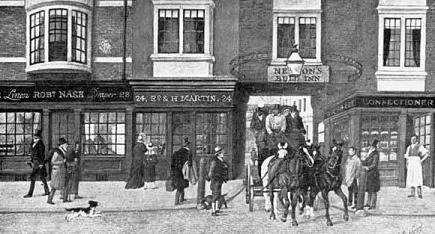Stagecoach to London
|
There was no direct stagecoach service to London from Burnham or the villages of the Dengie 100. The nearest point to catch a London bound Stagecoach was at Maldon or Chelmsford. From the mid 1700's the Maldon Fly provided a daily service from Maldon, initially to Shenfield and later to Chelmsford allowing passengers to pick up the London Coach The route to London then followed a line roughly similar to the Modern A12 road through Margaretting, Brentwood, Romford, Ilford and Stratford before terminating at the Bull at Whitechapel or one of the other great coaching inns in Eastern or Central London. From about 1800 local coaches ran from Burnham and Southminster to Maldon and carriers made regular journeys from most of the villages. Maldon Inns such as the Rose and Crown could offer overnight accommodation and stabling for horses catering for those people wealthy enough to own their own horses and even wealthier residents would have their own horse drawn carriages with groom in which they could travel to Maldon.
The coach for Eastern Essex departed at 10 o'clock in the morning on Monday's, Wednesday's and Friday's calling at Romford, Brentwood, Ingatestone, Margaretting, Mountnessing, Ingatestone, Widford, Chelmsford, Sandon, Baddow, Danbury, Purleigh, Woodham Mortimer, Maldon, Hazeleigh, St Lawrence, Bradwell, Snoreham, Cold Norton, Mayland, Althorne, Dengie, Steeple, Creeksea, Foulness, Burnham, Southminster. The better off would use a coach which provided a private covered carriage compete with guard and driver that provide a daily service from Burnham to Chelmsford and Brentwood to Aldgate but as the average wages were about 7 shillings and sixpence the cost of the coach at one pound two shillings was prohibitive for normal people. Coach travel to London started in the 1600's although they proved an uncomfortable and slow method of transport given their basic design and the bad state of the roads. One hundred years later design had been improved providing a slightly more comfortable ride although journeys were still slow. London to Chelmsford cost about 3 shillings which was well beyond the means of an average man After another hundred years in the mid 1800's coaches were fitted with springs and the roads were much improved making a coach trip quicker and more comfortable although the passengers taking a ride on the top still had to hang on tight for the whole journey! Journey times in this modern era were reduced to as little as 6 hours from London to Chelmsford. Even as the stagecoach reached its improved stage its days were numbered with the introduction of steam coaches to be followed by Motor Coaches and the killer blow of the ever growing railway network offering fast and cheap travel. |




